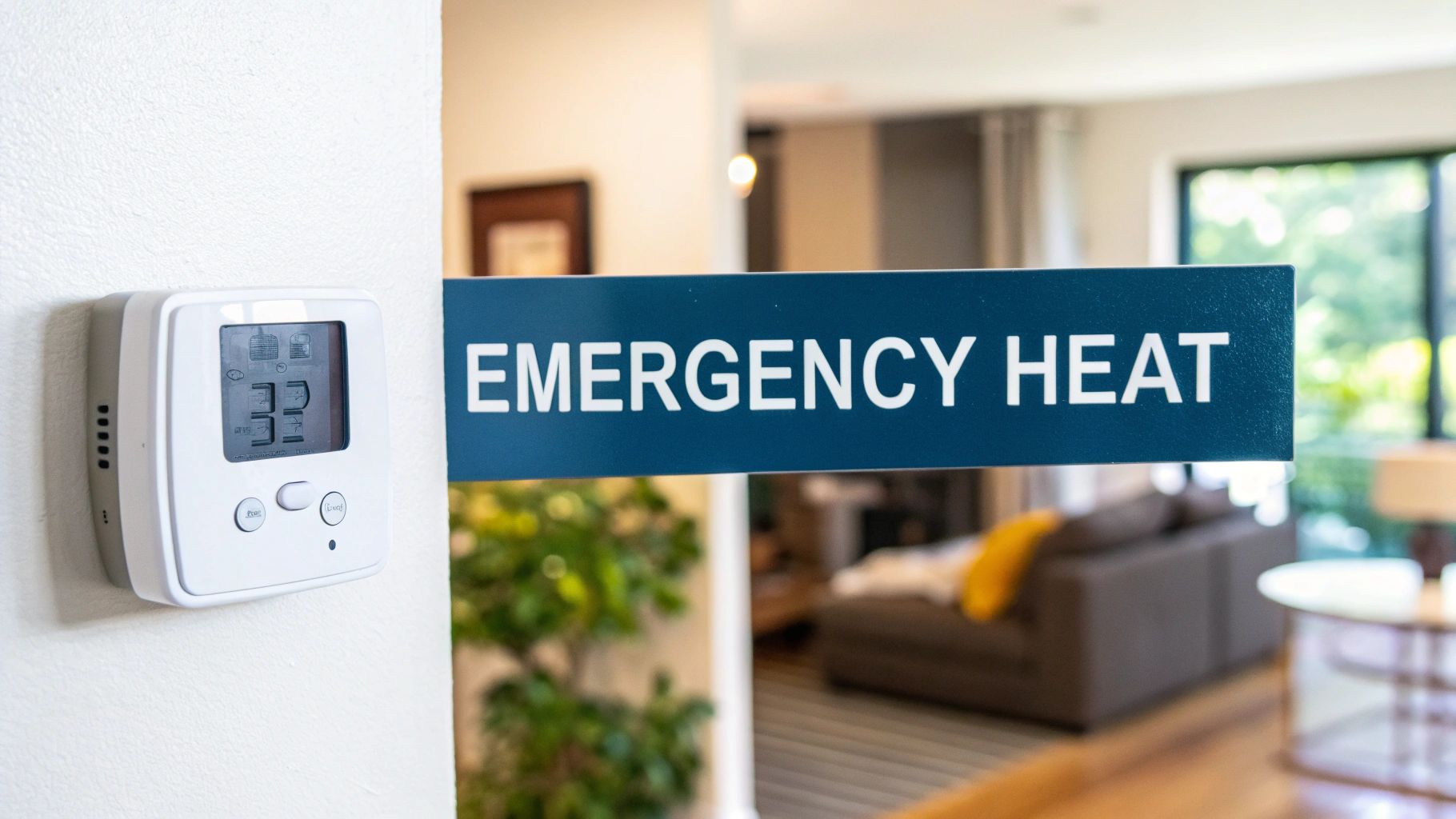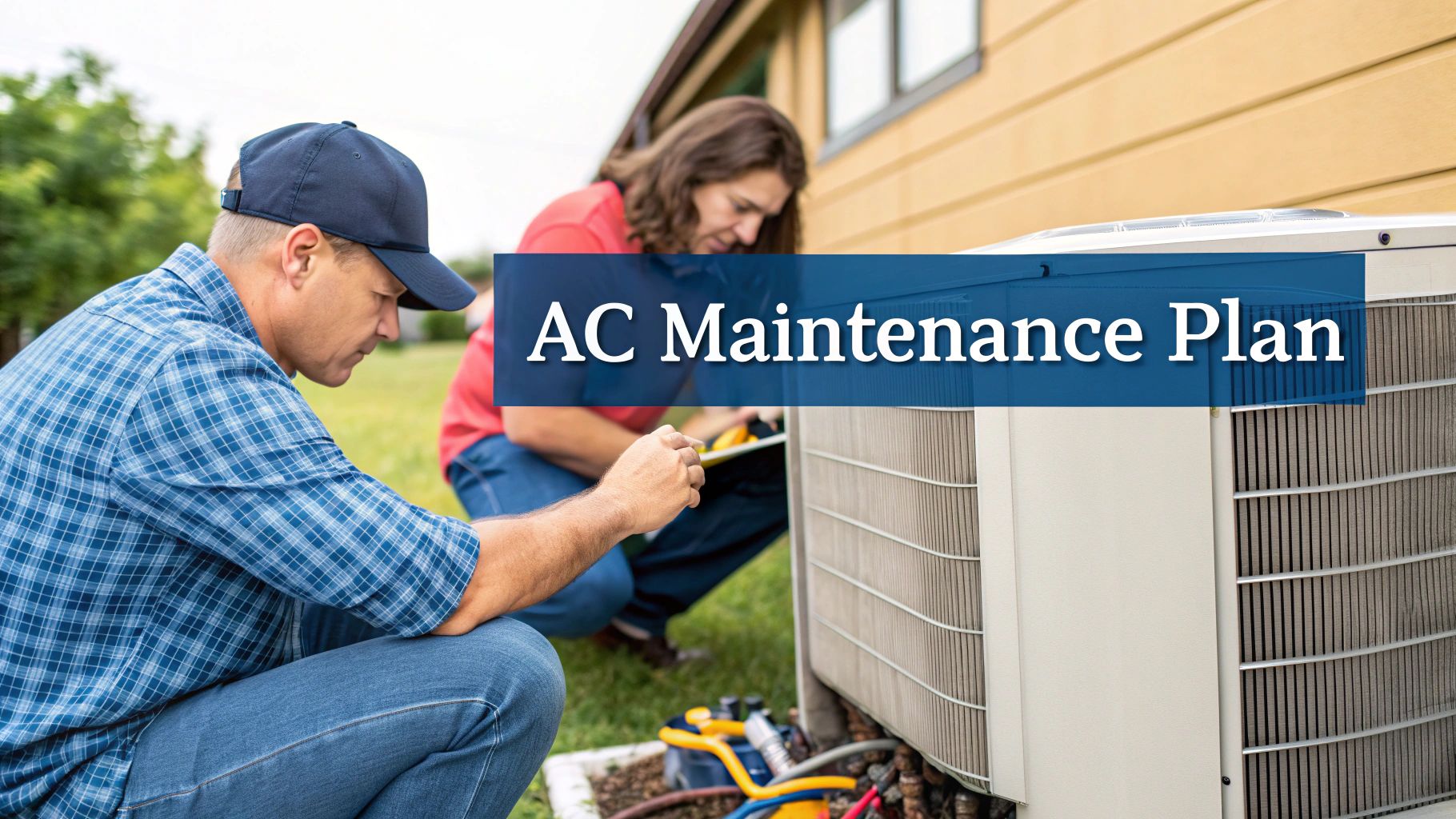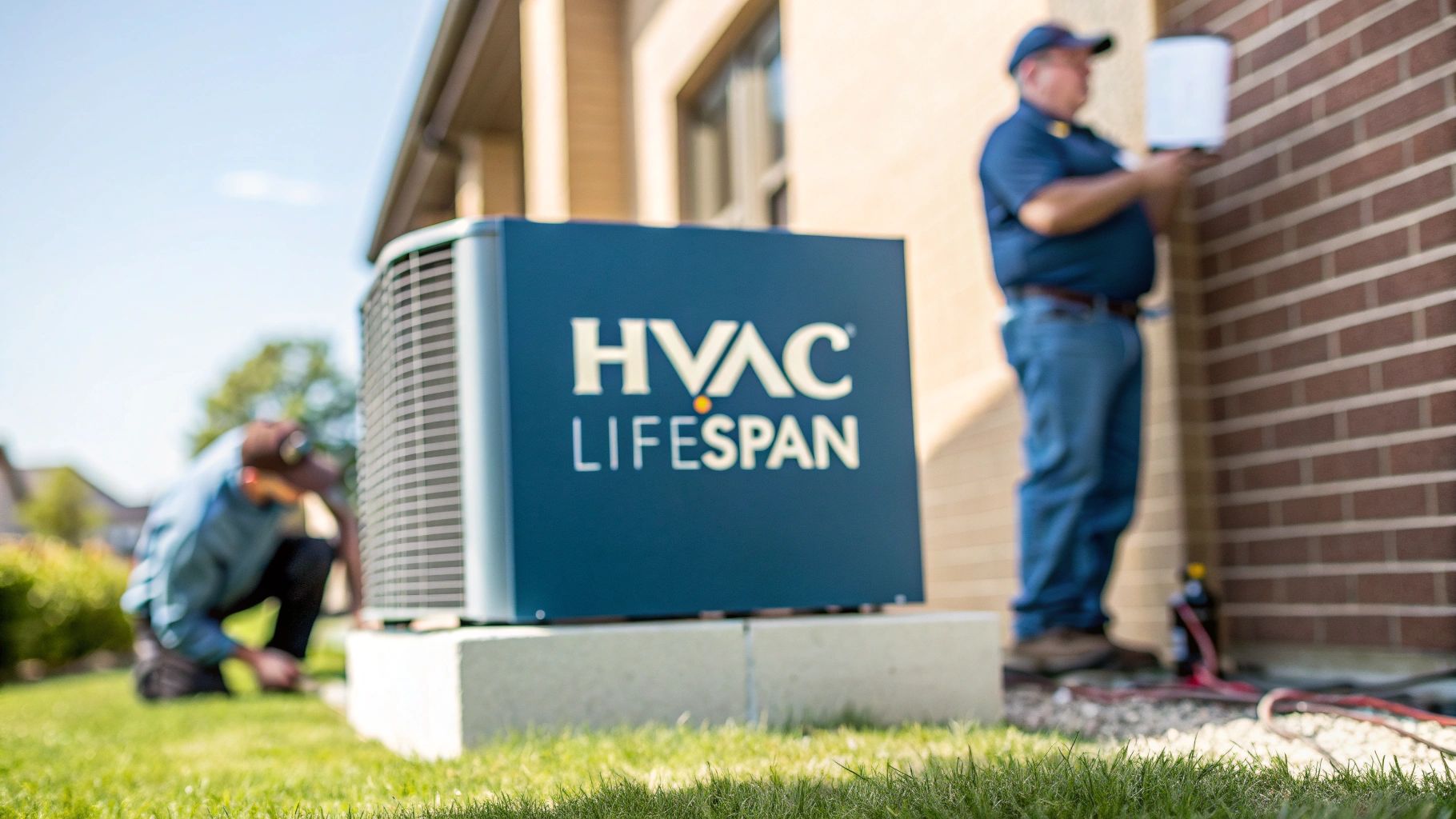Ever glanced at your thermostat and seen the “EM Heat” or “Emergency Heat” setting? If you have a heat pump, you’ve probably wondered what it’s for. Think of it as the spare tire for your heating system—it's there to get you out of a jam, but it's not meant for everyday driving.
The thermostat emergency heat setting is a manual override that switches your system to a secondary, more powerful heat source. It completely bypasses your heat pump and fires up electric resistance coils or, in some setups, a gas furnace. This feature is designed to keep you warm when your primary system either fails or just can't handle a deep freeze.
What Is the Emergency Heat Setting on My Thermostat
So, what exactly is that "EM Heat" light trying to tell you? It's your system's powerful backup plan. This setting is unique to homes with a heat pump, a clever device that heats your home by pulling warmth from the outside air and moving it inside.
This process is incredibly efficient under normal conditions. But when the temperature outside really plummets—usually somewhere below 35°F—the heat pump starts to struggle. There just isn't enough warmth in the air for it to grab.
That's where the thermostat emergency heat setting comes into play. It takes over when the heat pump can’t keep up, activating a more direct and potent heat source to maintain a comfortable temperature indoors. Knowing when and why to use it is the key to staying warm without getting a shocking energy bill.
Distinguishing Primary and Backup Systems
Your heating system really has two different gears. Your primary system, the heat pump, is the efficient daily driver. The backup system, your emergency heat, is the heavy-duty specialist you call on only when absolutely necessary. Just like learning what the 'Hold' function means on a Honeywell thermostat, understanding this distinction is crucial for running your system efficiently.
Emergency heat isn't a "super heat" button to warm up the house faster on a chilly day. It's a complete system takeover. When you flip that switch, you're telling your heat pump to stand down and letting the secondary source do all the work.
This infographic gives you a great visual of how the emergency heat function looks on a typical thermostat.
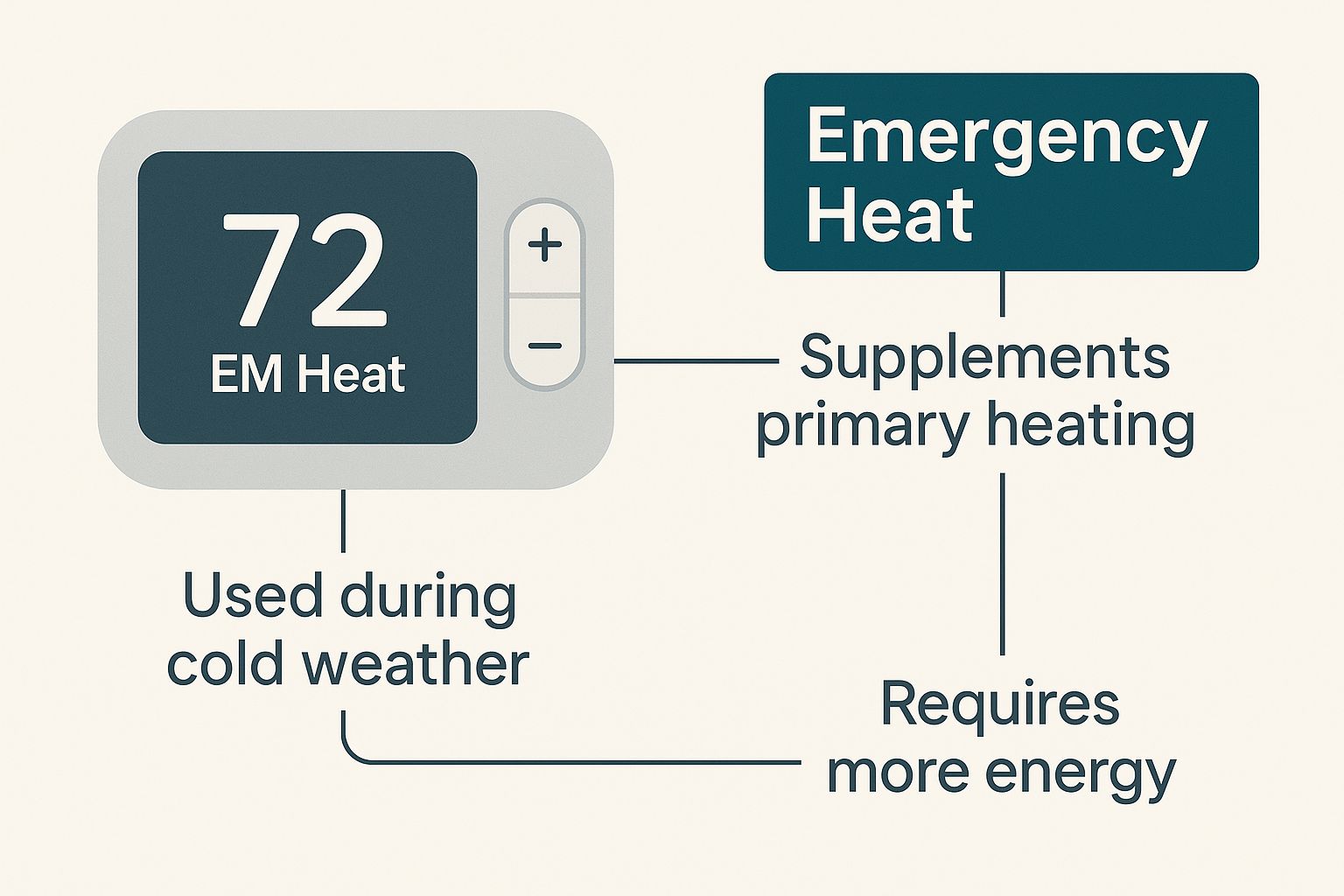
As you can see, the "EM Heat" indicator is separate from the standard "Heat" mode, clearly showing it's a switch to a different system. Knowing the pros and cons of heat pumps in general can give you a better sense of why this backup is so important. And trust me, the difference between these two modes will show up big time on your utility bill.
To make it even clearer, let's break down how your primary heat pump stacks up against its emergency backup.
Heat Pump vs Emergency Heat At a Glance
| Feature | Heat Pump (Primary Heat) | Emergency Heat (Secondary Heat) |
|---|---|---|
| How It Works | Transfers heat from outside air to inside your home | Generates heat directly using electric coils or a furnace |
| Energy Efficiency | Very high; moves heat rather than creating it | Low; uses significant electricity to create heat |
| Best For | Mild to moderately cold weather (typically above 35-40°F) | Extreme cold (below 35°F) or when the heat pump is malfunctioning |
| Operating Cost | Lower; uses less energy | Higher; can cause a sharp spike in your energy bill |
| System Role | Your everyday, go-to heating source | A backup for true emergencies or extreme weather |
In short, your heat pump is the marathon runner, built for endurance and efficiency, while the emergency heat is the sprinter—powerful but quickly exhausts your energy resources.
How Emergency Heat Actually Works
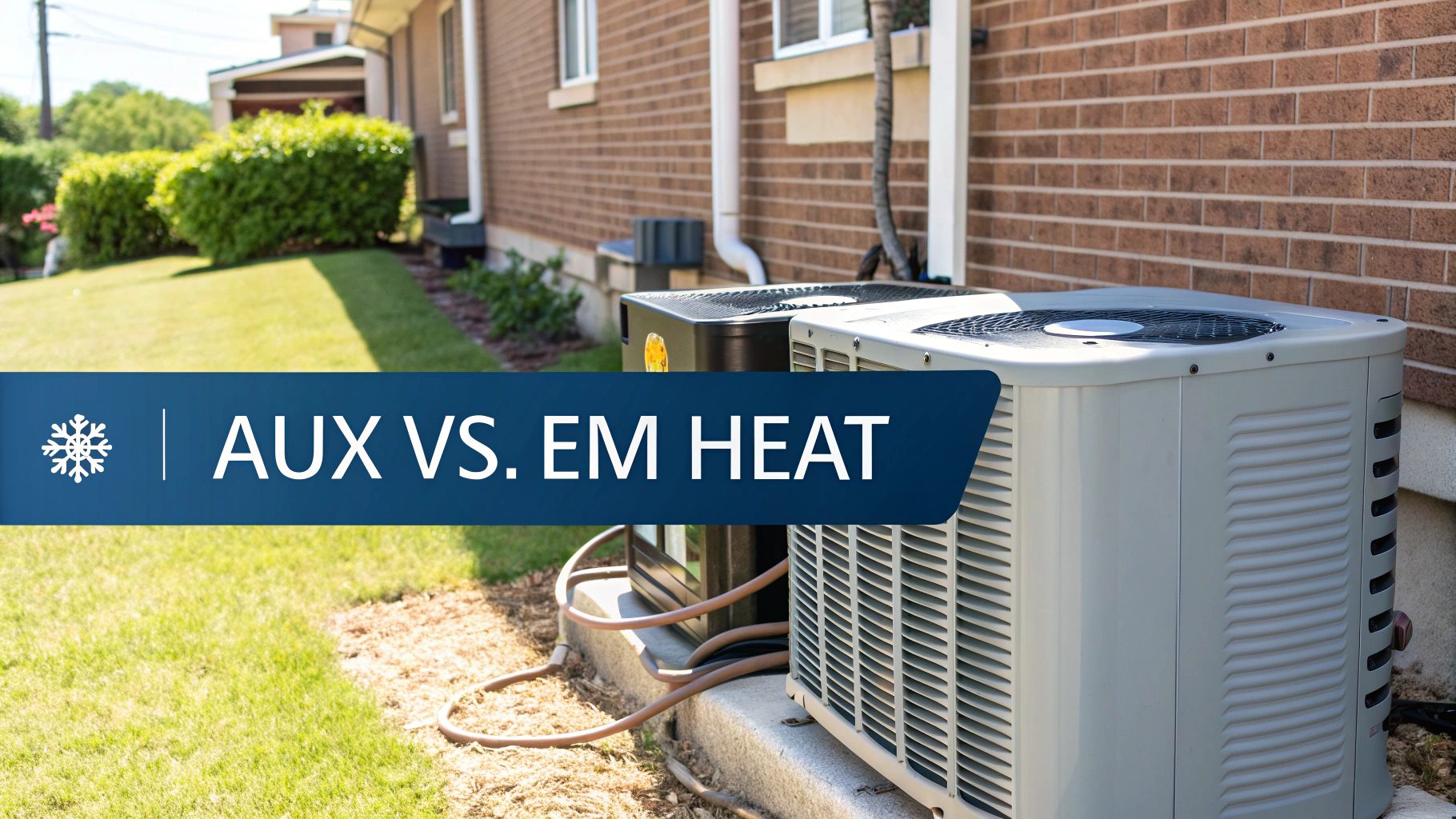
To get a handle on what the thermostat emergency heat setting does, it helps to think of your HVAC system as having two different ways to make your home toasty. The first is your heat pump, which is the smart, efficient workhorse. It doesn't actually generate heat; instead, it cleverly pulls warmth from the outside air and moves it inside.
That system works brilliantly most of the time. But when the temperature really plunges, typically somewhere below 30-35°F, the heat pump starts to have a hard time. There just isn't enough heat left in the frigid air for it to grab and move effectively. This is when your system knows it needs a little backup.
Auxiliary Heat: The Automatic Assistant
Before we dive into emergency heat, you need to know about its cousin: auxiliary heat. You've probably seen "AUX" pop up on your thermostat before. When your heat pump is running but just can't keep up with the temperature you've set, the auxiliary heat automatically fires up to lend a hand.
This backup is usually a series of electric resistance coils tucked inside your indoor air handler. The best way to picture them is like the coils in a giant toaster. They glow hot, and your system’s blower pushes air across them, sending a serious wave of warmth through your vents. This happens on its own to help the heat pump, not to take over.
Emergency Heat: The Manual Override
So, what makes the thermostat emergency heat setting different? It’s all about who’s in charge. When you manually switch to "EM Heat," you're making the call to completely bypass your outdoor heat pump unit.
You’re essentially telling your system, "Forget the heat pump for now. Just fire up those electric coils and have them do all the work." This command switches your home's heating over to that powerful but less-efficient backup source. It becomes the only thing heating your house.
The crucial difference is control. Auxiliary heat is an automatic helper that works alongside your heat pump. Emergency heat is a manual command that forces the system to rely exclusively on its backup.
That's precisely why it's meant for true emergencies, like when your heat pump breaks down in the middle of a cold snap. Thermostat technology has come a long way, but this fundamental backup function is still a critical feature for anyone with a heat pump.
The kind of backup you have—whether it’s electric strips or a small furnace—plays a big role in your home's energy use. If you’re not sure what you’re working with, you can learn more by checking out our guide on how to tell if central air is electric or gas. Knowing your system is the first step to managing your energy bills, especially if you ever find yourself needing that "EM Heat" switch.
Knowing When to Use Emergency Heat
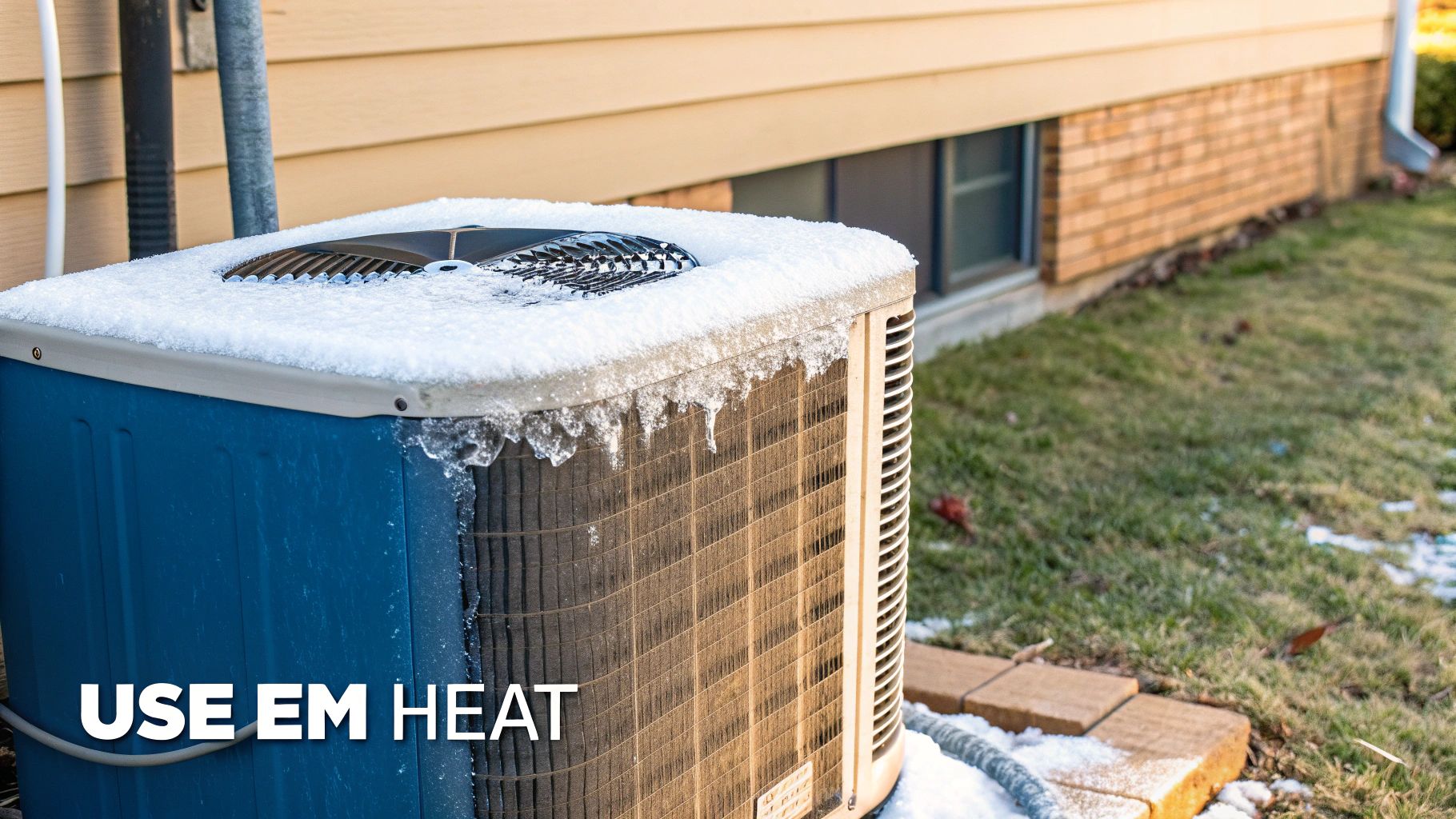
Knowing when to flip the switch to your thermostat's emergency heat setting is critical—getting it wrong can be a surprisingly expensive mistake. This isn't a "turbo" button for a chilly morning or a way to warm up the house faster. Think of it more like a lifeboat for your home's heating system, meant only for very specific, dire situations.
Turning on the emergency heat should always be a deliberate choice, not just a reaction to the weather report. There are really only two scenarios where "EM Heat" is the right move. Learning to spot them will keep you warm without putting your system, or your bank account, under unnecessary stress.
When Your Heat Pump Is Malfunctioning
The number one reason to use emergency heat is simple: your main heating system, the heat pump itself, has failed. You might notice the outdoor unit isn't running at all, is making some truly awful noises, or looks like a giant ice sculpture. When that happens, it can no longer pull warmth from the outside air.
Without a working heat pump, your house will get cold, fast. Switching to emergency heat provides a crucial, temporary lifeline. It completely bypasses the broken outdoor unit, firing up the internal electric heating strips to keep your home at a safe temperature until an HVAC pro can get there to fix the real problem.
Key Takeaway: If you think your heat pump is broken, switch to emergency heat right away to stay warm, and then call for service. Don't let a busted heat pump keep trying to run—you could turn a small repair into a major replacement.
During Extreme and Prolonged Cold Snaps
The second situation is less about a breakdown and more about your heat pump just being completely outmatched by mother nature. Heat pumps are efficiency champs, but their magic starts to fade as the mercury drops. In a truly brutal cold snap, especially when temps stay well below 30°F for days on end, you'll feel the difference.
Your heat pump might seem like it's running nonstop, but the temperature inside just won't climb to what you've set on the thermostat. The air coming from the vents might even feel cool. That’s the classic sign your heat pump is fighting a losing battle against the extreme cold.
In these rare cases, manually switching to emergency heat can give your system the raw heating power it needs to get your home comfortable again. Once the worst of the cold snap breaks, remember to switch it back to the normal "Heat" setting.
Understanding the Real Cost of Emergency Heat
When that "EM Heat" light pops on, it’s natural to wonder what it's doing to your wallet. The short answer? Using your thermostat emergency heat setting is much, much more expensive than running your heat pump normally. It's a difference you'll definitely notice on your next utility bill.
So, why the huge price jump? It all comes down to how emergency heat actually makes heat. It uses a method called electric resistance heating—think of it as the same technology inside a toaster or a space heater. It’s powerful, but it’s an energy hog. You're essentially firing up a series of massive, built-in space heaters to warm your entire house, which burns through an incredible amount of electricity.
The Numbers Behind the High Cost
Let's put some real numbers to it. Running your system on emergency heat can easily cost three to five times more than using your heat pump. That's not a small jump. Even a few days of relying on it can lead to a surprisingly painful electric bill.
This setting is designed to be a temporary lifeline when your primary system fails, not a go-to heating source. While market analysts keep a close eye on thermostat trends, as seen in reports on the overall thermostat market, there isn't much data on how often homeowners actually flip that emergency switch. What we do know is that when they do, the cost impact is felt right at home.
The table below gives you a clear, side-by-side look at what a day of heating can cost.
Estimated Daily Heating Cost Comparison
This table shows the potential cost difference between a standard heat pump and the emergency heat setting over a typical 8-hour heating period.
| Heating Mode | Average Energy Use (kWh) | Estimated Daily Cost (at $0.15/kWh) |
|---|---|---|
| Heat Pump | 12 kWh | $1.80 |
| Emergency Heat | 48 kWh | $7.20 |
As you can see, what seems like a simple switch has a major financial consequence. That $5.40 daily difference adds up fast, highlighting why this setting is truly for emergencies only.
Seeing these figures makes it obvious why knowing your system is so crucial. The best way to sidestep these high costs is to be prepared. For more year-round savings strategies, our guide on how to lower your electric bill has plenty of practical tips.
In the end, using emergency heat correctly isn't just about staying warm—it's about protecting yourself from an unexpectedly huge utility bill.
Troubleshooting Common Emergency Heat Problems
https://www.youtube.com/embed/F88Y9NkvtQw
It's one of those sinking feelings—you notice something is off with your thermostat emergency heat setting. Maybe it won't shut off, or worse, it won't turn on when you desperately need it. Either way, it's stressful.
But don't panic. Before you pick up the phone to call a pro, there are a few simple things you can check yourself. Running through these basic steps can often solve the problem and save you a service call.
Emergency Heat Is Stuck On
Seeing that "EM Heat" light glowing on your thermostat when it shouldn't be can be unnerving, especially when you think about your next energy bill. This usually points to a few common culprits.
First, go straight to the source: the thermostat. Someone might have switched it to "EM Heat" manually and simply forgot to turn it back to the regular "Heat" setting. It happens! If the setting is correct, however, the problem could be a faulty thermostat or a wiring issue.
Next, head outside and take a good look at your heat pump unit. Is it caked in ice or buried in snow? A frozen-over heat pump can't do its job, which forces your system to automatically switch over to the backup heat strips. If your unit looks like an iceberg, that's a clear sign of a bigger problem that needs a technician to diagnose.
When to Call a Pro: If you’ve double-checked the thermostat setting and your outdoor unit is clear, but that emergency heat light is still on, it’s time to call for help. A system stuck in emergency mode often signals a serious issue with your heat pump, like a failing compressor or low refrigerant.
Emergency Heat Will Not Turn On
On the flip side, what if you actually need the emergency heat and it's not working? When the cold is creeping in, this is a much more urgent problem.
The very first place to look is your circuit breaker. The electric heat strips that make up your emergency heat system draw a ton of power, and it's not uncommon for them to trip a breaker. Go to your electrical panel, look for any tripped circuits, and flip them back on. Sometimes, the problem is deeper in your home's electrical system. If you're curious about the fundamentals, you can learn more about topics like how to replace a fuse box.
Another common offender is a severely clogged air filter. If the filter is choked with dust and debris, it can restrict airflow so much that the system's safety sensors will shut down the heating elements to prevent them from overheating. Pull your filter out and check it—if it’s dirty, a new one might be all you need.
Quick Troubleshooting Checklist:
- Check Thermostat Settings: Is "EM Heat" actually selected?
- Inspect Circuit Breaker: Find your panel and reset any breakers that have tripped.
- Replace Air Filter: A dirty filter is a common cause of system shutdowns.
- Verify Power to Unit: Look for a power switch on or near your indoor furnace/air handler and make sure it's on.
If you’ve run through this list and still have no heat, you’re likely dealing with a more technical problem. It could be a failed heating element or a faulty control board, both of which require a certified technician to repair safely.
Your Top Questions About Emergency Heat, Answered
Even with a good handle on the basics, you probably still have a few questions about that emergency heat setting on your thermostat. That's completely normal—it's not a button you press every day. Let's clear up some of the most common questions we get from homeowners.
Think of this as your quick-reference guide for those specific "what-if" moments. We want to make sure you're confident about how your system works and when to use this important feature.
What’s the Difference Between "Aux" and "Emergency" Heat?
This is, without a doubt, the number one question people ask. It’s confusing because both modes use the exact same hardware: the electric resistance heating strips. The real difference is how they get turned on.
Auxiliary heat is your system’s automatic helper. Imagine your heat pump is working hard on a really cold day but just can't keep up. Your system is smart enough to recognize this and automatically kicks on the "aux" heat for an extra boost. It works in partnership with your heat pump.
The thermostat emergency heat setting, however, is a manual command from you. When you flip that switch, you’re telling the system, "Ignore the heat pump completely and only use the backup electric heat." It's not a helper; it's a complete takeover.
Does Emergency Heat Actually Warm the House Faster?
It's a common myth, but the answer is a definite no. While those electric coils get intensely hot, your system's blower fan has a speed limit. It can only push so much air through your home at once, no matter how hot the heat source is.
Flipping on the emergency heat won't get you to your target temperature any quicker, but it will make your electric meter spin like a top. It’s a wildly inefficient way to heat your home and should never be used as a "heat-up-fast" button. For steady, efficient warmth, just let your regular heat setting do its job.
Using emergency heat to warm up faster is like flooring it at every red light. You'll burn through a ton of gas but won't get to your destination any sooner.
Will Emergency Heat Work During a Power Outage?
Unfortunately, no. Your entire central HVAC system—the thermostat, the indoor fan, and the electric heating strips themselves—is completely dependent on electricity. Without power, nothing works.
If the power goes out, the emergency heat setting can't save the day. It’s a backup for a broken heat pump, not a backup for a power grid failure.
How Long Is It Safe to Run on Emergency Heat?
You should only run your system on the thermostat emergency heat setting for as little time as absolutely necessary. Its entire purpose is to be a temporary solution that keeps your pipes from freezing until a professional can fix your heat pump.
We’re talking hours, or maybe a day or two at most. If you leave it on for days or weeks, you’re going to get an electric bill that will absolutely shock you. The moment you switch to emergency heat, your very next step should be calling a certified HVAC technician. It’s not a long-term fix by any stretch of the imagination.
If your heat pump is on the fritz or you're stuck using emergency heat, don't put off the repair. A small problem can quickly turn into a major headache. The expert technicians at Florida Cooling Group are on call 24/7 to get your system diagnosed and repaired, bringing back comfort and efficiency to your home. You can schedule your professional HVAC service today by visiting us at https://floridacoolinggroup.com.

 (561) 400-2205
(561) 400-2205